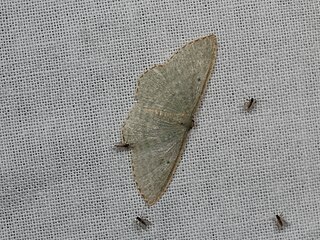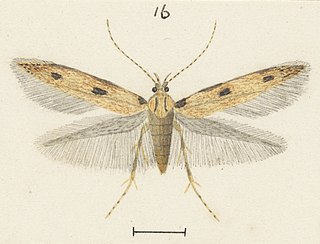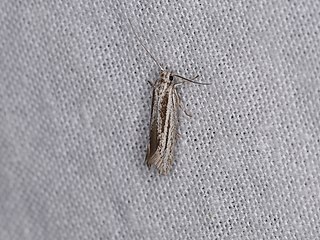
Microdes squamulata is a species of moth of the family Geometridae. It is found in Australia, including Tasmania.

Microdes villosata is a species of moth of the family Geometridae. It is found in Australia, including Tasmania.

Microdes is a genus of moths in the family Geometridae.

Poecilasthena balioloma is a moth of the family Geometridae first described by Alfred Jefferis Turner in 1907. It is found in Australia, including Tasmania.
Poecilasthena cisseres is a moth of the family Geometridae first described by Alfred Jefferis Turner in 1933. It is found in Australia, including Victoria.

Eupitheciini is a tribe of geometer moths under subfamily Larentiinae, often referred to as pugs. The tribe was described by Tutt in 1896.

Labdia anarithma is a moth of the family Cosmopterigidae. It was described by Edward Meyrick in 1888. It is found in New Zealand and throughout Australia. Adults are on the wing from December to March and are day flying. They have been collected by sweeping bracken fern.
Aeolochroma pammiges is a moth of the family Geometridae first described by Alfred Jefferis Turner in 1941. It is found in Queensland, Australia.
Protophyta benigna is a moth of the family Geometridae first described by Alfred Jefferis Turner in 1939. It is found in Queensland, Australia.
Rhuma thiobapta is a moth of the family Geometridae first described by Alfred Jefferis Turner in 1936. It is found in Queensland, Australia.
Eupithecia tornolopha is a moth in the family Geometridae first described by Alfred Jefferis Turner in 1942. It is found in Australia.
Chloroclystis elaeopa is a moth in the family Geometridae. It was described by Alfred Jefferis Turner in 1908. It is found in Queensland, Australia.
Gymnoscelis bryodes is a moth in the family Geometridae. It was described by Alfred Jefferis Turner in 1907. It is found in Australia.
Gymnoscelis callichlora is a moth in the family Geometridae. It was described by Alfred Jefferis Turner in 1907 and it is found in Australia (Queensland).
Gymnoscelis tanaoptila is a moth in the family Geometridae. It was described by Alfred Jefferis Turner in 1907. It is found in Australia (Queensland).
Microdes asystata is a moth in the family Geometridae. It is found in Australia.

Microdes diplodonta is a moth in the family Geometridae. It is found in Australia.
Microdes haemobaphes is a moth in the family Geometridae. It is found in Australia.
Archephanes zalosema is a medium-sized moth in the family Geometridae that is native to Australia. The species was first described by Alfred Jefferis Turner in 1926. Its wings are green and marbled with black in a way that makes them look like lichen. It has a wingspan of 4 centimeters. It has back wings, hidden when resting, that have a pale brown colour. Underneath the wings is a pale brown colour. The antennae of Archephanes zalosema are not branched. Typical of sexual dimorphism among Lepidoptera the male is smaller than the female.

Antipterna ptychomochla is a species of moth in the family Oecophoridae, first described by Alfred Jefferis Turner in 1940 as Antiterpna ptychomochla (sic). The species epithet derives from the Greek, πτυκομοχλοσ, meaning "with bar on fold".






